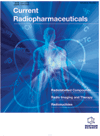-
s The Screening of Renoprotective Agents by 99mTc-DMSA: A Review of Preclinical Studies
- Source: Current Radiopharmaceuticals, Volume 12, Issue 3, Dec 2019, p. 211 - 219
-
- 01 Dec 2019
Abstract
Background: Nephrotoxicity is a prevalent consequence of cancer treatment using radiotherapy and chemotherapy or their combination. There are two methods; histological and biochemical, to assess the kidney damage caused by toxic agents in animal studies. Although these methods are used for the try-out of renoprotective factors, these methods are invasive and time-consuming, and also, lack the necessary sensitivity for primary diagnosis. Quantitative renal 99mTc-DMSA scintigraphy is a noninvasive, precise and sensitive radionuclide technique which is used to assess the extent of kidney damage, so that the extent of injury to the kidney will be indicated by the renal uptake rate of 99mTc-DMSA in the kidney. In addition, this scintigraphy evaluates the effect of the toxic agents by quantifying the alterations in the biodistribution of the radiopharmaceutical. Conclusion: In this review, the recent findings about the renoprotective agents were evaluated and screened with respect to the use of 99mTc-DMSA , which is preclinically and clinically used for animal cases and cancer patients under the treatment by radiotherapy and chemotherapy.


